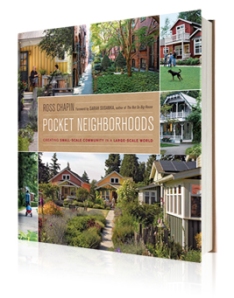A Placemaking Journal
Livin’ Large in Small Spaces: It Takes a Town
I’m big on small.
Ever since the 2005 Misissippi Renewal Forum in the wake of Hurricane Katrina, I’ve been beating the drum for Katrina Cottages and cottage neighborhoods. Most recently here and, in 2009, here.
I haven’t exactly been a voice in the wilderness. In fact, I wasn’t even among the early wave of advocates.
North Carolina’s Sarah Susanka and her “Not So Big” books tapped into what turned out to be a pent-up demand for well-thought-out, smaller scale home design. And Pacific Northwest architect
Ross Chapin demonstrated a premium market for new-era cottage neighborhoods at the height of the McMansion craze. Now, thanks to demographic and economic pressures, the construction industry is not nearly as determined to super-size American housing as it was a half-dozen years ago. For a glimpse of how those changes are playing out, read Neal Peirce’s November, 2010 post in CitiWire and Wendy Koch’s recent story in USA TODAY.
Last fall and early winter, I got the chance to move from cottage living theory to real-life cottage living when I took Mississippi architect Bruce Tolar up on his offer to use the original Katrina Cottage as a temporary base of operations for a post-oil spill project on the Gulf Coast. For 90 days, I lived and worked out of the 308-square-foot cottage designed by Marianne Cusato during the Mississippi Renewal Forum and displayed at the 2006 International Builders Show in Orlando. For the story of how the “little yellow house” came into being, check out my interview with contractor Jason Spelling in this 2010 video:
Cusato’s cottage now nests comfortably on Tolar’s two-acre Cottage Square in Ocean Springs, Mississippi, one of 14 cottages that were among the early Katrina Cottage designs or were inspired by the movement. Next door, on another two acres, more than 30 new cottages, reflecting a further permutation of Katrina Cottages as workforce housing, are going in. So, soon there will be an intown neighborhood of 40-plus homes and offices ranging from a studio under 300 square feet to Tolar’s 1,300 square foot two-story design that he now uses as his office.
Which gets me to the first of three lessons learned – or at least underlined – by my live/work experience in Cottage Square: These structures are “better together.” They need a critical mass to achieve their promise as a viable alternative to neighborhoods of 3,000-square-foot-plus homes. Dropped randomly into acre-lot subdivisions and diminished by surrounding McMansions, they look eccentric and experimental. They need small-lot site-planning and the company of friends.
Here’s the second lesson confirmed by my life in 300 square feet: The space has to be beautifully designed and the construction detailed perfectly. Otherwise you’ve got exactly what Katrina Cottage critics warned against – a tricked-out trailer.
When you compress the volume, the first thing to go is wiggle room for sloppy decision-making. Compromise on design and construction quality, including material choices, and you’re off to the race to the bottom. That’s why Cusato, Tolar, Steve Mouzon and others fight so tenaciously against cheaping out on ceiling heights, window selections, flooring, roofing, and trim details.
That’s bad news for workforce housing advocates committed to driving prices per square foot down. Better to achieve the savings by intelligently compacting the space, as opposed to competing with production builders who amortize prices per square foot over thousands of under-performing square feet.
My third and most important take-away from 90 days in tight quarters is this: It takes a town.
If you want to make the move from a conventional, 2,500-square-foot home to one half that size appealing, you can’t do it with design alone or even with the combination of home and neighborhood design. The trick to living large in small spaces is to have great public places to go to – preferably by foot or on a bike – once you’re outside your private retreat. This argument echoes Scott Doyon’s pitch for balancing privacy and community. No problem feeding the private, nesting impulse with cottage living; but the smaller the nest, the bigger the balancing need for community. Big community. Bigger than a greenfield new town or village.
Tolar’s Cottage Square is an infill neighborhood that’s colonizing a commercial district with mixed use within a 15,000-person town. Within the sacred quarter-mile walk are schools, a super market, a YMCA with child care, retail, and bars and restaurants. Within a 15-minute bike ride is all that Ocean Springs has to offer, including its historic main street, a beach, marinas, and lots more retail, restaurant, and bar options. As impressed as I was with how Marianne Cusato achieved livability in 300 square feet, I would have felt imprisoned in that space if I couldn’t hop on a bike and enjoy Ocean Springs anytime I wanted.
Ross Chapin will have a new book in stores in the next month or so that speaks to some of these lessons: Pocket Neighborhoods: Creating Small Scale Community in a Large Scale World. And we’ll keep this discussion going at the New Partners for Smart Growth Conference in Charlotte, Feb. 2-5. Sarah Susanka, Ross Chapin, and I are on a Feb. 4 panel called “Taking ‘Not So Big’ to the Next Level: Pocket Neighborhoods as Urban Infill.”
Hope to see you there.
–Ben Brown









